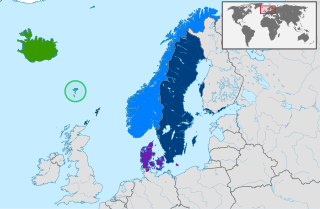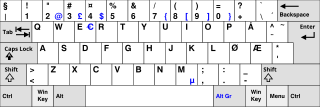
The Germanic languages are a branch of the Indo-European language family spoken natively by a population of about 515 million people mainly in Europe, North America, Oceania, and Southern Africa. The most widely spoken Germanic language, English, is also the world's most widely spoken language with an estimated 2 billion speakers. All Germanic languages are derived from Proto-Germanic, spoken in Iron Age Scandinavia, Iron Age Northern Germany and along the North Sea and Baltic coasts.

Norwegian is a North Germanic language from the Indo-European language family spoken mainly in Norway, where it is an official language. Along with Swedish and Danish, Norwegian forms a dialect continuum of more or less mutually intelligible local and regional varieties; some Norwegian and Swedish dialects, in particular, are very close. These Scandinavian languages, together with Faroese and Icelandic as well as some extinct languages, constitute the North Germanic languages. Faroese and Icelandic are not mutually intelligible with Norwegian in their spoken form because continental Scandinavian has diverged from them. While the two Germanic languages with the greatest numbers of speakers, English and German, have close similarities with Norwegian, neither is mutually intelligible with it. Norwegian is a descendant of Old Norse, the common language of the Germanic peoples living in Scandinavia during the Viking Age.

Old Norse, also referred to as Old Nordic, or Old Scandinavian, was a stage of development of North Germanic dialects before their final divergence into separate Nordic languages. Old Norse was spoken by inhabitants of Scandinavia and their overseas settlements and chronologically coincides with the Viking Age, the Christianization of Scandinavia, and the consolidation of Scandinavian kingdoms from about the 8th to the 15th centuries.

Swedish is a North Germanic language from the Indo-European language family, spoken predominantly in Sweden and parts of Finland. It has at least 10 million native speakers, making it the fourth most spoken Germanic language, and the first among its type in the Nordic countries overall.

The North Germanic languages make up one of the three branches of the Germanic languages—a sub-family of the Indo-European languages—along with the West Germanic languages and the extinct East Germanic languages. The language group is also referred to as the Nordic languages, a direct translation of the most common term used among Danish, Faroese, Icelandic, Norwegian, and Swedish scholars and people.
Bokmål is one of the official written standards for the Norwegian language, alongside Nynorsk. Bokmål is by far the most used written form of Norwegian today, as it is adopted by 85% to 90% of the population in Norway. There is no countrywide standard or agreement on the pronunciation of Bokmål and the spoken dialects vary greatly.
Nynorsk is one of the two official written standards of the Norwegian language, the other being Bokmål. From 12 May 1885, it became the state-sanctioned version of Ivar Aasen's standard Norwegian language (Landsmål), parallel to the Dano-Norwegian written standard known as Riksmål. The name Nynorsk was introduced in 1929. After a series of reforms, it is still the written standard closer to Landsmål, whereas Bokmål is closer to Riksmål and Danish.
Gutnish, or rarely Gutnic, is a North Germanic language spoken sporadically on the islands of Gotland and Fårö. The different dialects of Gutnish, while stemming from the Old Gutnish variety of Old Norse, are sometimes considered part of modern Swedish. Gutnish exists in two variants, Mainland Gutnish, mostly spoken in the southern and southeastern portion of Gotland, where the dialect of Lau became the standard form on the Main Island, and Fårö Gutnish, spoken on the island of Fårö. UNESCO defines Gutnish as a "definitely endangered language" as of 2010.

Meänkieli, or Tornedalian is a Finnic language or a group of distinct Finnish dialects spoken in the northernmost part of Sweden along the valley of the Torne River. Meänkieli is recognized in Sweden as one of the country's five minority languages and is treated as a distinct language from Finnish, however its status as an independent Finnic language is sometimes disputed due to its mutual intelligibility with Finnish. According to the National Association of Swedish Tornedalians, 70,000 individuals are able to understand Meänkieli, at least to some level.

Norwegian dialects are commonly divided into four main groups, 'Northern Norwegian', 'Central Norwegian', 'Western Norwegian', and 'Eastern Norwegian'. Sometimes 'Midland Norwegian' and/or 'South Norwegian' are considered fifth or sixth groups.
Svealand Swedish is one of the six major groupings of Swedish dialects, spoken in Svealand.
Swedish has a large vowel inventory, with nine vowels distinguished in quality and to some degree in quantity, making 18 vowel phonemes in most dialects. Another notable feature is the pitch accent, a development which it shares with Norwegian. Swedish pronunciation of most consonants is similar to that of other Germanic languages.
Standard Swedish denotes Swedish as a spoken and written standard language. While Swedish as a written language is uniform and standardized, the spoken standard may vary considerably from region to region. Several prestige dialects have developed around the major urban centers of Stockholm, Helsinki, Gothenburg and Malmö–Lund.
Old Swedish is the name for two distinct stages of the Swedish language that were spoken in the Middle Ages: Early Old Swedish, spoken from about 1225 until about 1375, and Late Old Swedish, spoken from about 1375 until about 1526.
Dalecarlian is a group of North Germanic languages and dialects spoken in Dalarna County, Sweden. Some Dalecarlian varieties can be regarded as part of the Swedish dialect group in Gästrikland, Uppland, and northern and eastern Västmanland. Others represent a variety characteristic of a midpoint between West and East Scandinavian languages, significantly divergent from Standard Swedish. In the northernmost part of the county, a characteristic dialect reminiscent of eastern Norwegian is spoken. One usually distinguishes between the Dalecarlian Bergslagen dialects, which are spoken in south-eastern Dalarna, and Dalecarlian proper. The dialects are traditionally regarded as part of the Svealand dialect group.

Swedish is the official language of Sweden and is spoken by the vast majority of the 10.23 million inhabitants of the country. It is a North Germanic language and quite similar to its sister Scandinavian languages, Danish and Norwegian, with which it maintains partial mutual intelligibility and forms a dialect continuum. A number of regional Swedish dialects are spoken across the country. In total, more than 200 languages are estimated to be spoken across the country, including regional languages, indigenous Sámi languages, and immigrant languages.

Many languages are spoken, written and signed in Norway.

Finnish is a Finnic language of the Uralic language family, spoken by the majority of the population in Finland and by ethnic Finns outside of Finland. Finnish is one of the two official languages of Finland, alongside Swedish. In Sweden, both Finnish and Meänkieli are official minority languages. Kven, which like Meänkieli is mutually intelligible with Finnish, is spoken in the Norwegian counties of Troms and Finnmark by a minority of Finnish descent.
Norrland dialects is one of the six major dialect groupings of the Swedish language. It comprises most dialects traditionally spoken in Norrland, except for those of Gästrikland and southern Hälsingland, which are usually classified as Svealand Swedish, as well as those of Härjedalen and northernmost Jämtland, which are usually classified as Norwegian.









